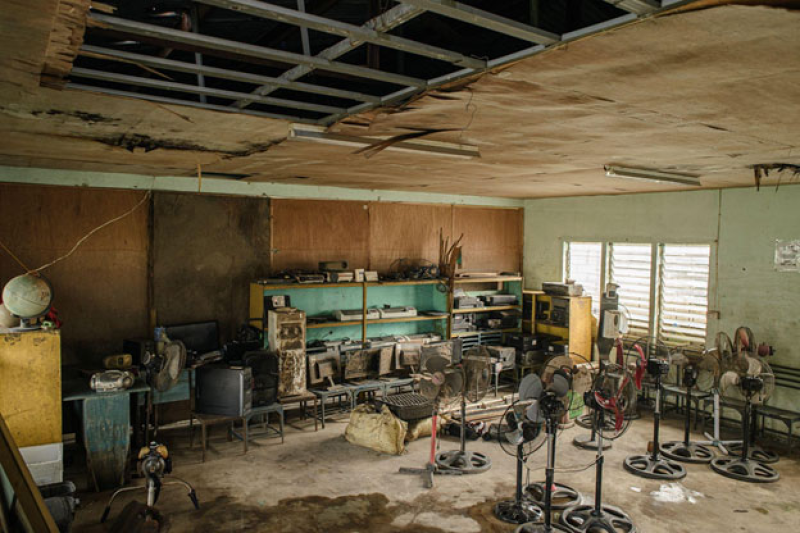- Bangladesh Lost $24B in 2024 as Extreme Heat Hits Economy |
- Remittance Surpasses $10b in Four Months of FY 2025-26 |
- Dhaka residents struggling with ‘unhealthy’ air quality |
- Over 100 Killed in Brazil’s Deadliest Rio Police Raid |
- Alphabet Tops $100 Billion Quarter as AI Drives Surge |
Children’s Education Must Be Central in COP30 Climate Talks

A damaged classroom and school equipment at Dahilig Elementary School in the Municipality of Gainza, Camarines Sur, Philippines, weeks after Severe Tropical Storm Kristine (Trami) wreaked havoc in October 2024.
In 2024, the climate crisis disrupted schooling for millions of students worldwide, weakening workforces and hindering social development on a massive scale. Extreme weather patterns have prevented students from accessing safe and effective learning environments. The United Nations (UN) and the Geneva Global Hub for Education in Emergencies (EiE Hub) continue to urge the international community to help the most climate-vulnerable regions build resilient education systems that empower both students and educators.
On October 28, members of the EiE Hub issued a statement calling on stakeholders and world leaders to place children’s education at the forefront of global discussions at COP30, to be held in Belém, Brazil, in November. Without urgent intervention, tens of millions of children risk falling behind in their education, which threatens long-term economic development and stability.
“Children are more vulnerable to the impacts of weather-related crises, including stronger and more frequent heatwaves, storms, droughts, and flooding,” said Catherine Russell, Executive Director of the United Nations Children’s Fund (UNICEF), in January. “Children cannot concentrate in classrooms that offer no respite from sweltering heat, and they cannot get to school if paths are flooded or schools are washed away. Last year, severe weather kept one in seven students out of class, threatening their health, safety, and long-term education.”
According to UNICEF, roughly half of the world’s school-aged children have access to quality education, with an estimated one billion living in countries described as “extremely high-risk” to climate shocks and natural disasters. The EiE Hub estimates that at least 242 million students experienced educational disruptions in 2024 due to climate-related events, with more than 118 million affected by heatwaves in May alone. Beyond affecting learning quality and teaching effectiveness, climate-induced disasters also increase the risk of school dropouts and expose children to heightened protection risks.
These challenges are particularly severe in communities across the Global South, where climate-induced disasters hit hardest. Frequent shocks devastate local economies, undermine adaptation efforts, and exacerbate pre-existing inequalities. Women, girls, displaced persons, and individuals with disabilities face disproportionately higher risks, including violence, adverse health impacts, loss of livelihoods, and increased rates of child, early, and forced marriage.
In August, a report by UNICEF and the UN Economic Commission for Latin America and the Caribbean (ECLAC) found that roughly 5.9 million children and adolescents in Latin America and the Caribbean could be pushed into poverty by 2030 due to lost education from climate change if governments do not intervene. In a worst-case scenario, the number could rise to 17.9 million.
According to UNESCO, the Asia-Pacific region is considered the world’s most climate-sensitive environment, where coastal and low-lying communities are disproportionately affected by rising sea levels and extreme weather. These communities often rely on fisheries and agriculture — climate-sensitive sectors — putting them at further risk.
A World Bank report, Gender Dimensions of Disaster Risk and Resilience, highlights the heightened vulnerability of boys and girls during climate-related shocks. In Fiji, households that lost one or both parents to climate-intensified disasters saw increased rates of school dropouts and child labour. The report found that girls who lost both parents were 26 percent less likely than boys to join the workforce within five years and 62 percent more likely to marry during the same period. In Uganda, the likelihood of child labour rises for both boys and girls following natural disasters.
“If children and young people don’t have the resources to meet their basic needs and develop their potential, and if adequate social protection systems are not in place, the region’s inequalities will only deepen,” said Roberto Benes, UNICEF Regional Director for Latin America and the Caribbean.
Despite this, education systems receive only a small fraction of available climate and government funding. From 2006 to March 2023, only 2.4 percent of multilateral climate action budgets went toward climate-resilient school programmes. According to the EiE Hub, less than half of the Nationally Determined Contributions (NDCs 2.0) were child-sensitive, leaving education largely overlooked by governments.
The EiE Hub calls on governments, donors, and civil society groups to make education a central part of climate action, especially in COP30 discussions. The organization emphasises that every US$1 invested in education can increase national GDP by approximately US$20.
The EiE Hub also stresses the importance of involving children and youth in climate policymaking, investing in resilient school infrastructure, and integrating green skills and climate learning into curricula. By doing so, education can become a powerful tool for resilience and climate action.

